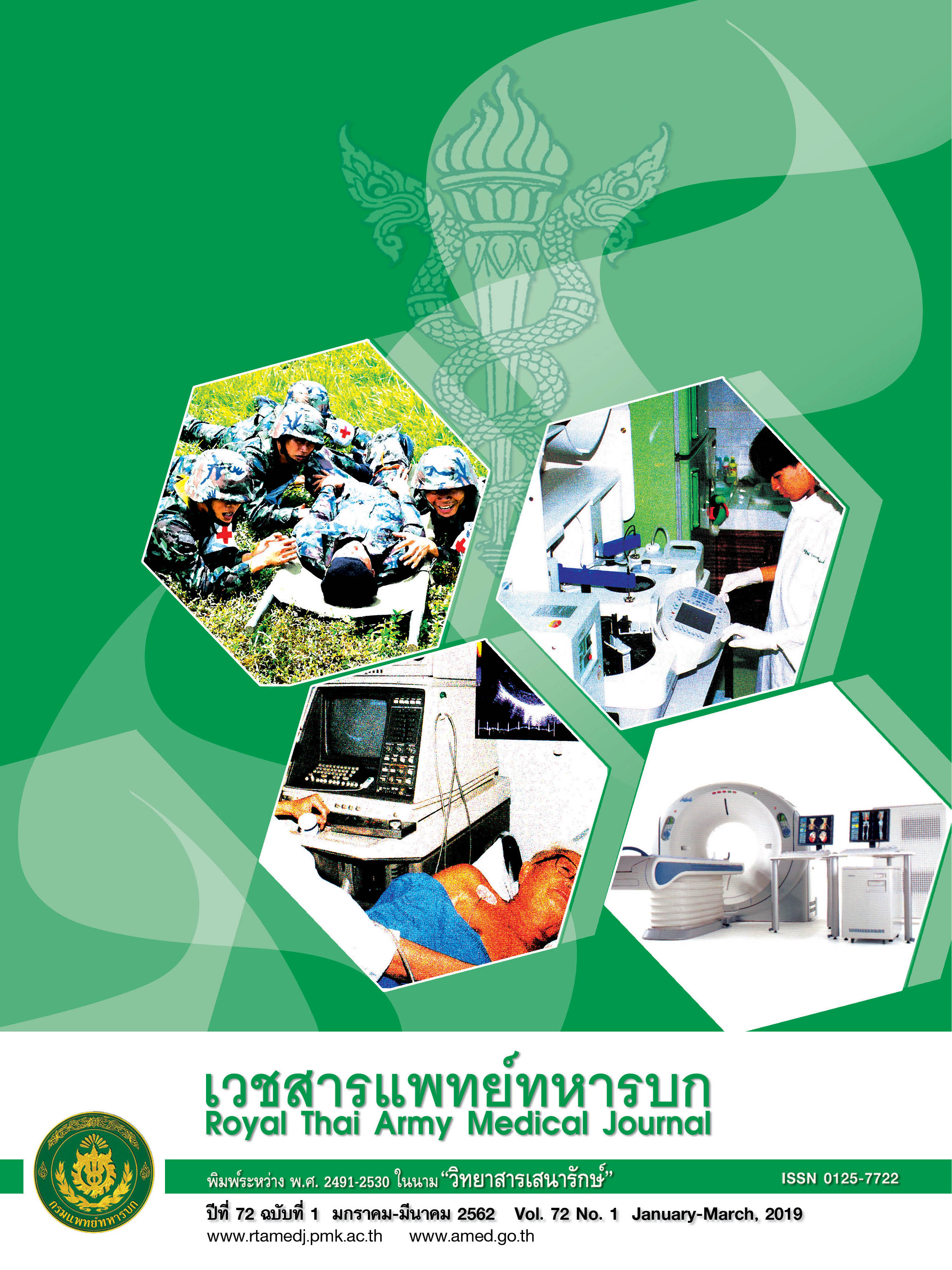อุบัติการณ์และปัจจัยที่เกี่ยวข้องของการบาดเจ็บจากการกระโดดร่มด้วยสายดึงประจำที่ในพลร่ม ที่เข้าฝึกหลักสูตรส่งทางอากาศ
Main Article Content
บทคัดย่อ
บทคัดย่อ
ความเป็นมา ในปัจจุบันยังไม่มีข้อมูลเกี่ยวกับอุบัติการณ์และปัจจัยที่เกี่ยวข้องกับการบาดเจ็บจากการกระโดดร่มที่จำเพาะต่อบริบทของประเทศไทย วัตถุประสงค์ เพื่อศึกษาอุบัติการณ์การบาดเจ็บและปัจจัยที่เกี่ยวข้องกับการบาดเจ็บจากการกระโดดร่มด้วยสายดึงประจำที่ของพลร่มในการฝึกหลักสูตรส่งทางอากาศ วิธีการศึกษา เป็นการศึกษาแบบไปข้างหน้า กลุ่มตัวอย่าง คือ กำลังพลที่เข้ารับการฝึกหลักสูตรส่งทางอากาศของโรงเรียนสงครามพิเศษช่วงเดือนกุมภาพันธ์ ถึง กรกฎาคม 2561 จำนวน 992 คน เก็บข้อมูลด้วยแบบบันทึกข้อมูล ซึ่งเก็บข้อมูล 3 ด้าน คือ (ก) ด้านข้อมูลทั่วไป (ข) ด้านสภาวะแวดล้อมในการกระโดดร่ม และ (ค) ด้านการบาดเจ็บจากการกระโดดร่ม วิเคราะห์ปัจจัยที่เกี่ยวข้องกับการบาดเจ็บจากการกระโดดร่มด้วยสถิติ Multi-level Poisson Regression โดยใช้ Incidence Rate Ratio (IRR) และช่วงความเชื่อมั่นที่ 95% (95%CI) เป็นตัวชี้วัดความสัมพันธ์
ผลการศึกษา กลุ่มตัวอย่างมีการบาดเจ็บจากการกระโดดร่มทั้งสิ้น 166 ครั้ง จากการกระโดดร่มทั้งหมด 4,677 ครั้ง อุบัติการณ์การบาดเจ็บจากการกระโดดร่มคิดเป็น35.50 ครั้ง/การกระโดดร่ม 1,000 ครั้ง (ช่วงความเชื่อมั่นที่ 95% ตั้งแต่ 30.04-41.21) ปัจจัยที่เกี่ยวข้องกับการบาดเจ็บจากการกระโดดร่มคือ การกระโดดร่มพร้อมสัมภาระเมื่อเทียบกับการกระโดดร่มโดยไม่มีสัมภาระ [Adjusted IRR (95%CI) = 1.28 (0.88-1.87)]การเพิ่มขึ้นของความเร็วลมทุก 1 น็อต [1.54 (1.27-1.87)] การกระโดดร่มจากเครื่องบินเมื่อเทียบกับเฮลิคอปเตอร์ [1.75 (0.68-4.55)]การออกจากอากาศยานทางด้านข้างเมื่อเทียบกับทางด้านหลัง [2.13 (1.43-3.23)] การกระโดดร่มในตอนกลางคืนเมื่อเทียบกับตอนกลางวัน [2.19 (0.81-5.90)] และการมีอาการเมาอากาศยาน [3.43 (1.93-6.92)] สรุป การป้องกันการบาดเจ็บจากการกระโดดร่มด้วยสายดึงประจำที่สามารถทำได้โดยการควบคุมปัจจัยในด้าน ชนิดของอากาศยาน ทางออกของอากาศยาน ช่วงเวลาในการกระโดดร่ม การกระโดดร่มพร้อมสัมภาระ อาการเมาอากาศยาน และความเร็วลม
Downloads
Article Details
บทความในวารสารนี้อยู่ภายใต้ลิขสิทธิ์ของ กรมแพทย์ทหารบก และเผยแพร่ภายใต้สัญญาอนุญาต Creative Commons Attribution-NonCommercial-NoDerivatives 4.0 International (CC BY-NC-ND 4.0)
ท่านสามารถอ่านและใช้งานเพื่อวัตถุประสงค์ทางการศึกษา และทางวิชาการ เช่น การสอน การวิจัย หรือการอ้างอิง โดยต้องให้เครดิตอย่างเหมาะสมแก่ผู้เขียนและวารสาร
ห้ามใช้หรือแก้ไขบทความโดยไม่ได้รับอนุญาต
ข้อความที่ปรากฏในบทความเป็นความคิดเห็นของผู้เขียนเท่านั้น
ผู้เขียนเป็นผู้รับผิดชอบต่อเนื้อหาและความถูกต้องของบทความของตนอย่างเต็มที่
การนำบทความไปเผยแพร่ซ้ำในรูปแบบสาธารณะอื่นใด ต้องได้รับอนุญาตจากวารสาร


